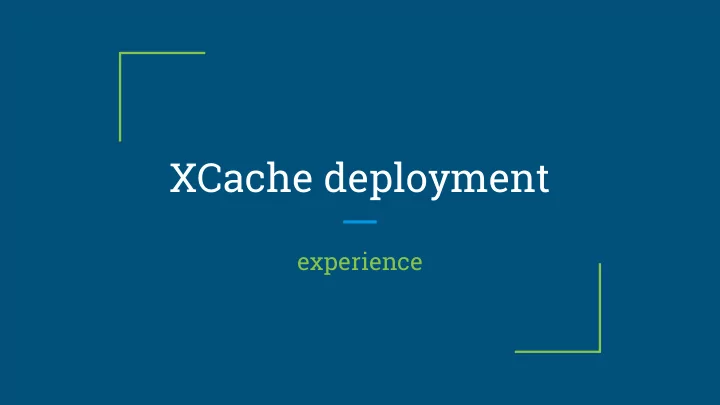

XCache deployment experience
What is XCache? Basically an xrootd proxy server that also stores data passing through it. On next access it delivers data from disk. It needs: a) “Dedicated” node b) Local storage c) IP d) Secrets (to authenticate against origin servers) e) Integration with ATLAS workflows (RUCIO, AGIS, monitoring)
First big choice Xcache can be setup as a standalone or as a cluster. I chose standalone: Simpler deployment (only xrootd service, no cmsd needed) ● ● Reliability ● External control of individual nodes Cluster anyhow does not rebalances disk usage ● We are still far from utilizing single node instances fully and efficiently ●
Docker container Everything in a github repo and docker image built automatically in dockerhub, documentation in github too. The image is rather basic: ● Based on centos ● Xrootd-server, xrootd-client, vomsxrd, fetch-crl, python,... xrootd user has fixed GID and UID ● Creates all directories needed, makes them owned by xrootd (but only if ● needed!)
XCache: Containers ● Sets few default environment variables if not already defined. ● Sleeps 2 min for x509 container to finish first update of CA 3 containers run in each pod: ● Starts server ● Activates itself in AGIS using REST API ● Sleeps indefinitely ● xcache - server itself x509 - renews proxy ● X509: ● Updated x509 proxy reporter - collects info on cached ● ● Fetches crls files and sends to logstash ● sleeps 6 h Reporter: All server configuration done through ● Collects info from .cinfo files environment variables. ● Reports to ES ● Sleeps 1h
Server - K8s deployment Secrets: service certificate (2 files) As k8s deployment (not a simple pod) Since it requires special node it uses nodeSelector You don’t want anything else using this node so * Volume to be used for caching is a hostPath Liveness probe on server container All configs done through environment variables. In hindsight it would be nicer to use ConfigMaps.
Service is a NodePort. IP is fixed. Stress test - k8s deployment Used to stress test any xcache instance and report about results. Uses the same image, same secrets, just runs different code.
Helm chart Maybe an overkill for app this simple, but required by slate and makes config more readable. Basically replaced values with placeholders like this:
Helm values Clean and with a lot of comments (not shown here).
Recommend
More recommend